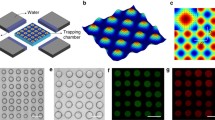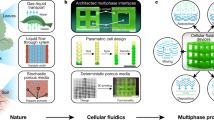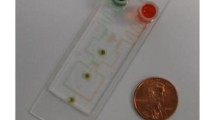Abstract
We describe a novel method which makes use of polymer-based aqueous two-phase systems to pattern bacterial communities inside Petri dishes. This method allows us to culture submillimeter-sized bacterial communities in spatially distinct spots while maintaining a degree of chemical connectedness to each other through the aqueous phase. Given sufficient time, these bacterial cultures develop biofilms, each corresponding to the footprint of the droplet spot. This method can be used to study the interactions between bacterial communities and biofilms spotted adjacent to each other. Furthermore, it can be extended to study the interactions between different bacterial communities and an underlying epithelial cell layer.
Access this chapter
Tax calculation will be finalised at checkout
Purchases are for personal use only
Similar content being viewed by others
References
McEldowney S, Fletcher M (1987) Adhesion of bacteria from mixed cell suspension to solid surfaces. Arch Microbiol 148:57–62
Flemming HC, Wingender J (2010) The biofilm matrix. Nat Rev Microbiol 8:623–633
Rao D, Webb JS, Kjelleberg S (2005) Competitive interactions in mixed-species biofilms containing the marine bacterium Pseudoalteromonas tunicata. Appl Environ Microbiol 71:1729–1736
Lee JH, Lee J (2010) Indole as an intercellular signal in microbial communities. FEMS Microbiol Rev 34:426–444
Bansal T, Englert D, Lee J et al (2007) Differential effects of epinephrine, norepinephrine, and indole on Escherichia coli O157: H7 chemotaxis, colonization, and gene expression. Infect Immun 75:4597–4607
Sperandio V, Torres AG, Jarvis B et al (2003) Bacteria-host communication: the language of hormones. Proc Natl Acad Sci U S A 100:8951–8956
Richardson AE, Barea JM, McNeill AM et al (2009) Acquisition of phosphorus and nitrogen in the rhizosphere and plant growth promotion by microorganisms. Plant Soil 321:305–339
Weibel DB, Lee A, Mayer M et al (2005) Bacterial printing press that regenerates its ink: contact-printing bacteria using hydrogel stamps. Langmuir 21:6436–6442
Eun YJ, Weibel DB (2009) Fabrication of microbial biofilm arrays by geometric control of cell adhesion. Langmuir 25:4643–4654
Kim HJ, Boedicker JQ, Choi JW et al (2008) Defined spatial structure stabilizes a synthetic multispecies bacterial community. Proc Natl Acad Sci U S A 105:18188–18193
Kim J, Hegde M, Jayaraman A (2010) Co-culture of epithelial cells and bacteria for investigating host-pathogen interactions. Lab Chip 10:43–50
Tavana H, Jovic A, Mosadegh B et al (2009) Nanolitre liquid patterning in aqueous environments for spatially defined reagent delivery to mammalian cells. Nat Mater 8:736–741
Tavana H, Mosadegh B, Takayama S (2010) Polymeric aqueous biphasic systems for non-contact cell printing on cells: engineering heterocellular embryonic stem cell niches. Adv Mater 22:2628–2631
Yaguchi T, Lee S, Choi WS et al (2010) Micropatterning bacterial suspensions using aqueous two phase systems. Analyst 135:2848–2852
Yaguchi T, Dwidar M, Byun CK et al (2012) Aqueous two-phase system-derived biofilms for bacterial interaction studies. Biomacromolecules 13:2655–2661
Byun CK, Hwang H, Choi WS et al (2013) Productive chemical interaction between a bacterial microcolony couple is enhanced by periodic relocation. J Am Chem Soc 135:2242–2247
Dwidar M, Leung BM, Yaguchi T et al (2013) Patterning bacterial communities on epithelial cells. PLoS One 8:e67165
Frampton JP, White JB, Abraham AT et al (2013) Cell co-culture patterning using aqueous two-phase systems. J Vis Exp. 73: e50304 doi:10.3791/50304
Tomlin KL, Clark SRD, Ceri H (2004) Green and red fluorescent protein vectors for use in biofilm studies of the intrinsically resistant Burkholderia cepacia complex. J Microbiol Meth 57:95–106
Acknowledgments
We would like to thank Dr. Toshiyuki Yaguchi at Nagoya Institute of Technology, Japan, and Dr. Brendan M. Leung at the University of Michigan, USA, for their contributions in establishing the protocols discussed in this chapter.
This work was supported by a grant from the Creativity and Innovation Project funded by Ulsan National Institute of Science and Technology (UNIST) (Grant #1.120051.01) and by the World Class University (WCU) program (No. R322008000200540) through the National Research Foundation of Korea (NRF) as funded by the Ministry of Education, Science and Technology (MEST). The authors appreciate the support.
Author information
Authors and Affiliations
Corresponding author
Editor information
Editors and Affiliations
Rights and permissions
Copyright information
© 2014 Springer Science+Business Media New York
About this protocol
Cite this protocol
Dwidar, M., Takayama, S., Mitchell, R.J. (2014). Aqueous Two-Phase System Technology for Patterning Bacterial Communities and Biofilms. In: Donelli, G. (eds) Microbial Biofilms. Methods in Molecular Biology, vol 1147. Humana Press, New York, NY. https://doi.org/10.1007/978-1-4939-0467-9_2
Download citation
DOI: https://doi.org/10.1007/978-1-4939-0467-9_2
Published:
Publisher Name: Humana Press, New York, NY
Print ISBN: 978-1-4939-0466-2
Online ISBN: 978-1-4939-0467-9
eBook Packages: Springer Protocols




